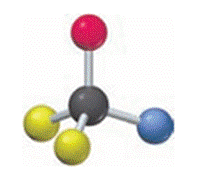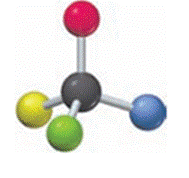
CHEMISTRY-TEXT
8th Edition
ISBN: 9780134856230
Author: Robinson
Publisher: PEARSON
expand_more
expand_more
format_list_bulleted
Concept explainers
Question
Chapter 23, Problem 23.32CP
Interpretation Introduction
(a)
Interpretation:
Whether the molecule is chiral or not needs to be determined.

Concept introduction:
Chiral molecule is a molecule with a tetrahedral central atom and four different substituent groups. This molecule is chiral because in the mirror image the substituent groups have a different geometric arrangement in space.
Interpretation Introduction
(b)
Interpretation:
Whether the given molecule is chiral or not needs to be determined.

Concept introduction:
Chiral molecule is a molecule with a tetrahedral central atom and four different substituent groups. This molecule is chiral because in the mirror image the substituent groups have a different geometric arrangement in space.
Expert Solution & Answer
Want to see the full answer?
Check out a sample textbook solution
Students have asked these similar questions
Plan the synthesis of the following compound using the starting material provided and any other reagents
needed as long as carbon based reagents have 3 carbons or less. Either the retrosynthesis or the forward
synthesis (mechanisms are not required but will be graded if provided) will be accepted if all necessary
reagents and intermediates are shown (solvents and temperature requirements are not needed unless
specifically involved in the reaction, i.e. DMSO in the Swem oxidation or heat in the KMnO4 oxidation).
There may be more than one correct answer, and chemically correct steps will be accepted. Extra points
will be given if correct names are provided. The points earned here will be applied to your lowest exam
score!
H
H
Draw the mechanism to make the alcohol 1-hexanol. Please use arrows.
Answer the followings:
1-What is the difference(s) between DNA and RNA:
a- Structure:
b- Function:
c- Types:
2-What is the meaning of:
a- Replication
b- Transcription
c- Translation
3- Show the base pair connection (hydrogen bond) in DNA and RNA
Chapter 23 Solutions
CHEMISTRY-TEXT
Ch. 23 - Prob. 23.1PCh. 23 - Prob. 23.2ACh. 23 - Prob. 23.3PCh. 23 - Prob. 23.4ACh. 23 - Prob. 23.5PCh. 23 - Prob. 23.6ACh. 23 - Draw a complete electron-dot structure for...Ch. 23 - Limonene is the major component in the oil of...Ch. 23 - Draw an orbital overlap picture for methyl a mine...Ch. 23 - Prob. 23.10A
Ch. 23 - Draw an orbital overlap picture for formaldehyde,...Ch. 23 - Prob. 23.12ACh. 23 - Prob. 23.13PCh. 23 - Prob. 23.14ACh. 23 - Prob. 23.15PCh. 23 - Draw complete electron-dot structures from the...Ch. 23 - Prob. 23.17PCh. 23 - Prob. 23.18ACh. 23 - Draw a simplified orbital overlap picture of...Ch. 23 - Prob. 23.20ACh. 23 - Prob. 23.21PCh. 23 - Prob. 23.22ACh. 23 - Prob. 23.23PCh. 23 - Prob. 23.24ACh. 23 - Prob. 23.25PCh. 23 - Prob. 23.26ACh. 23 - Asparagine is a naturally occurring aminoacid that...Ch. 23 - Prob. 23.28PCh. 23 - Prob. 23.29PCh. 23 - Prob. 23.30CPCh. 23 - Prob. 23.31CPCh. 23 - Prob. 23.32CPCh. 23 - Prob. 23.33CPCh. 23 - Prob. 23.34CPCh. 23 - Prob. 23.35CPCh. 23 - The following structure is a representation of...Ch. 23 - Prob. 23.37CPCh. 23 - Prob. 23.38CPCh. 23 - Prob. 23.39CPCh. 23 - Prob. 23.40SPCh. 23 - Prob. 23.41SPCh. 23 - Draw a straight-chain alkane with 6 carbon atoms...Ch. 23 - Prob. 23.43SPCh. 23 - Prob. 23.44SPCh. 23 - Prob. 23.45SPCh. 23 - The following line drawings represent two amino...Ch. 23 - Prob. 23.47SPCh. 23 - Prob. 23.48SPCh. 23 - Prob. 23.49SPCh. 23 - Prob. 23.50SPCh. 23 - Prob. 23.51SPCh. 23 - Prob. 23.52SPCh. 23 - Prob. 23.53SPCh. 23 - Prob. 23.54SPCh. 23 - Prob. 23.55SPCh. 23 - Prob. 23.56SPCh. 23 - Prob. 23.57SPCh. 23 - Prob. 23.58SPCh. 23 - Give a line drawing and molecular formula for the...Ch. 23 - Prob. 23.60SPCh. 23 - Prob. 23.61SPCh. 23 - Prob. 23.62SPCh. 23 - Prob. 23.63SPCh. 23 - Prob. 23.64SPCh. 23 - Prob. 23.65SPCh. 23 - Draw the complete electron-dot structure and...Ch. 23 - Prob. 23.67SPCh. 23 - Prob. 23.68SPCh. 23 - Prob. 23.69SPCh. 23 - Prob. 23.70SPCh. 23 - Prob. 23.71SPCh. 23 - Prob. 23.72SPCh. 23 - Prob. 23.73SPCh. 23 - Prob. 23.74SPCh. 23 - Prob. 23.75SPCh. 23 - Prob. 23.76SPCh. 23 - Prob. 23.77SPCh. 23 - Prob. 23.78SPCh. 23 - Prob. 23.79SPCh. 23 - Prob. 23.80SPCh. 23 - Prob. 23.81SPCh. 23 - Prob. 23.82SPCh. 23 - Prob. 23.83SPCh. 23 - Prob. 23.84SPCh. 23 - Prob. 23.85SPCh. 23 - Prob. 23.86SPCh. 23 - What does it mean to say that fats and oils are...Ch. 23 - Prob. 23.88SPCh. 23 - Prob. 23.89SPCh. 23 - Prob. 23.90SPCh. 23 - Prob. 23.91SPCh. 23 - Prob. 23.92SPCh. 23 - Prob. 23.93SPCh. 23 - Prob. 23.94SPCh. 23 - Prob. 23.95SPCh. 23 - Prob. 23.96SPCh. 23 - Prob. 23.97SPCh. 23 - Prob. 23.98SPCh. 23 - Prob. 23.99SPCh. 23 - Prob. 23.100SPCh. 23 - Prob. 23.101SPCh. 23 - Prob. 23.102SPCh. 23 - Prob. 23.103SPCh. 23 - Prob. 23.104SPCh. 23 - Prob. 23.105SPCh. 23 - Prob. 23.106SPCh. 23 - Prob. 23.107SPCh. 23 - Prob. 23.108SPCh. 23 - Prob. 23.109SPCh. 23 - Prob. 23.110SPCh. 23 - Prob. 23.111SPCh. 23 - Prob. 23.112SPCh. 23 - Prob. 23.113SPCh. 23 - What amino acids do the following abbreviations...Ch. 23 - Name and draw the structures of amino acids that...Ch. 23 - Identify the amino acids present in the following...Ch. 23 - Prob. 23.117SPCh. 23 - Prob. 23.118SPCh. 23 - Prob. 23.119SPCh. 23 - Prob. 23.120SPCh. 23 - Prob. 23.121SPCh. 23 - Prob. 23.122SPCh. 23 - Prob. 23.123SPCh. 23 - Prob. 23.124SPCh. 23 - Prob. 23.125SPCh. 23 - Prob. 23.126SPCh. 23 - Prob. 23.127SPCh. 23 - Prob. 23.128SPCh. 23 - Prob. 23.129SPCh. 23 - Prob. 23.130SPCh. 23 - Prob. 23.131SPCh. 23 - Prob. 23.132SPCh. 23 - Prob. 23.133SPCh. 23 - Prob. 23.134MPCh. 23 - Prob. 23.135MPCh. 23 - Cytochrome c is an important enzyme found in the...Ch. 23 - Prob. 23.137MPCh. 23 - Prob. 23.138MP
Knowledge Booster
Learn more about
Need a deep-dive on the concept behind this application? Look no further. Learn more about this topic, chemistry and related others by exploring similar questions and additional content below.Similar questions
- Why does the anhydride react with the OH on the benzene rather than the OH on the carboxy group?arrow_forwardAnswer the followings: 1- What is the IP for a amino acid? Give example. 2- What are the types of amino acids? 3- What are the structures of protein? 4- The N-Terminal analysis by the Edman method shows saralasin contains sarcosine at the N- terminus. Partial hydrolysis of saralasin with dilute hydrochloric acid yields the following fragments: Tyr-Val-His Sar-Arg-Val His-Pro-Ala Val-Tyr-Val Arg-Val-Tyr What is the structure of saralasin? 5. MATCH a term from the list below to each definition. Place the letter of the term in the blank to the left of the definition. a. Ligases b. Fibrous proteins c. Conjugated protein d. Hydrolases a. b. C. e. Simple protein f. Globular proteins g. Lyases h. Transferases Proteins that are tough and insoluble in water. Enzymes that catalyze the breaking away of a small molecule such as from a substrate. Enzymes that catalyze the bonding together of two substrates.arrow_forwardAnswer the followings (Four): 1-What is the difference(s) between FOUR: a. Glyceride and phosphoglyceride. b. Wax and fat. c. Soap and fatty acid. d. HDL and LDL cholesterol e. Phospho lipids and sphingosine. 2-What are the types of lipids? 3-What are the main lipid components of membrane structures? 4-How could lipids play important rules as signaling molecules and building units? 5. The Structure variety of Lipids makes them to play significant rules in our body. Conclude briefly on this statement.arrow_forward
arrow_back_ios
SEE MORE QUESTIONS
arrow_forward_ios
Recommended textbooks for you

 Chemistry for Today: General, Organic, and Bioche...ChemistryISBN:9781305960060Author:Spencer L. Seager, Michael R. Slabaugh, Maren S. HansenPublisher:Cengage Learning
Chemistry for Today: General, Organic, and Bioche...ChemistryISBN:9781305960060Author:Spencer L. Seager, Michael R. Slabaugh, Maren S. HansenPublisher:Cengage Learning Chemistry: The Molecular ScienceChemistryISBN:9781285199047Author:John W. Moore, Conrad L. StanitskiPublisher:Cengage Learning
Chemistry: The Molecular ScienceChemistryISBN:9781285199047Author:John W. Moore, Conrad L. StanitskiPublisher:Cengage Learning Chemistry: Principles and PracticeChemistryISBN:9780534420123Author:Daniel L. Reger, Scott R. Goode, David W. Ball, Edward MercerPublisher:Cengage Learning
Chemistry: Principles and PracticeChemistryISBN:9780534420123Author:Daniel L. Reger, Scott R. Goode, David W. Ball, Edward MercerPublisher:Cengage Learning Organic ChemistryChemistryISBN:9781305580350Author:William H. Brown, Brent L. Iverson, Eric Anslyn, Christopher S. FootePublisher:Cengage Learning
Organic ChemistryChemistryISBN:9781305580350Author:William H. Brown, Brent L. Iverson, Eric Anslyn, Christopher S. FootePublisher:Cengage Learning


Chemistry for Today: General, Organic, and Bioche...
Chemistry
ISBN:9781305960060
Author:Spencer L. Seager, Michael R. Slabaugh, Maren S. Hansen
Publisher:Cengage Learning


Chemistry: The Molecular Science
Chemistry
ISBN:9781285199047
Author:John W. Moore, Conrad L. Stanitski
Publisher:Cengage Learning

Chemistry: Principles and Practice
Chemistry
ISBN:9780534420123
Author:Daniel L. Reger, Scott R. Goode, David W. Ball, Edward Mercer
Publisher:Cengage Learning

Organic Chemistry
Chemistry
ISBN:9781305580350
Author:William H. Brown, Brent L. Iverson, Eric Anslyn, Christopher S. Foote
Publisher:Cengage Learning